Comprehensive Analysis: Factors Influencing Employee Motivation
VerifiedAdded on 2023/06/14
|8
|1918
|489
Report
AI Summary
This report explores the multifaceted concept of employee motivation, delving into the various factors that drive individuals to work, including salary, promotion opportunities, and the work environment. It examines motivation through the lens of Maslow's hierarchy of needs, differentiating between extrinsic and intrinsic motivational forces. The report further analyzes the positive impacts of job roles, such as improved knowledge, personal and professional development, and valuable work experience. Conversely, it addresses the negative factors employees may encounter, including conflicts, work pressure, and unfavorable working conditions. Finally, the report outlines strategies for coping with these negative factors, emphasizing the importance of motivation, leadership, and training and development programs to foster a positive and productive work environment. Desklib provides a platform to access this and many other solved assignments.
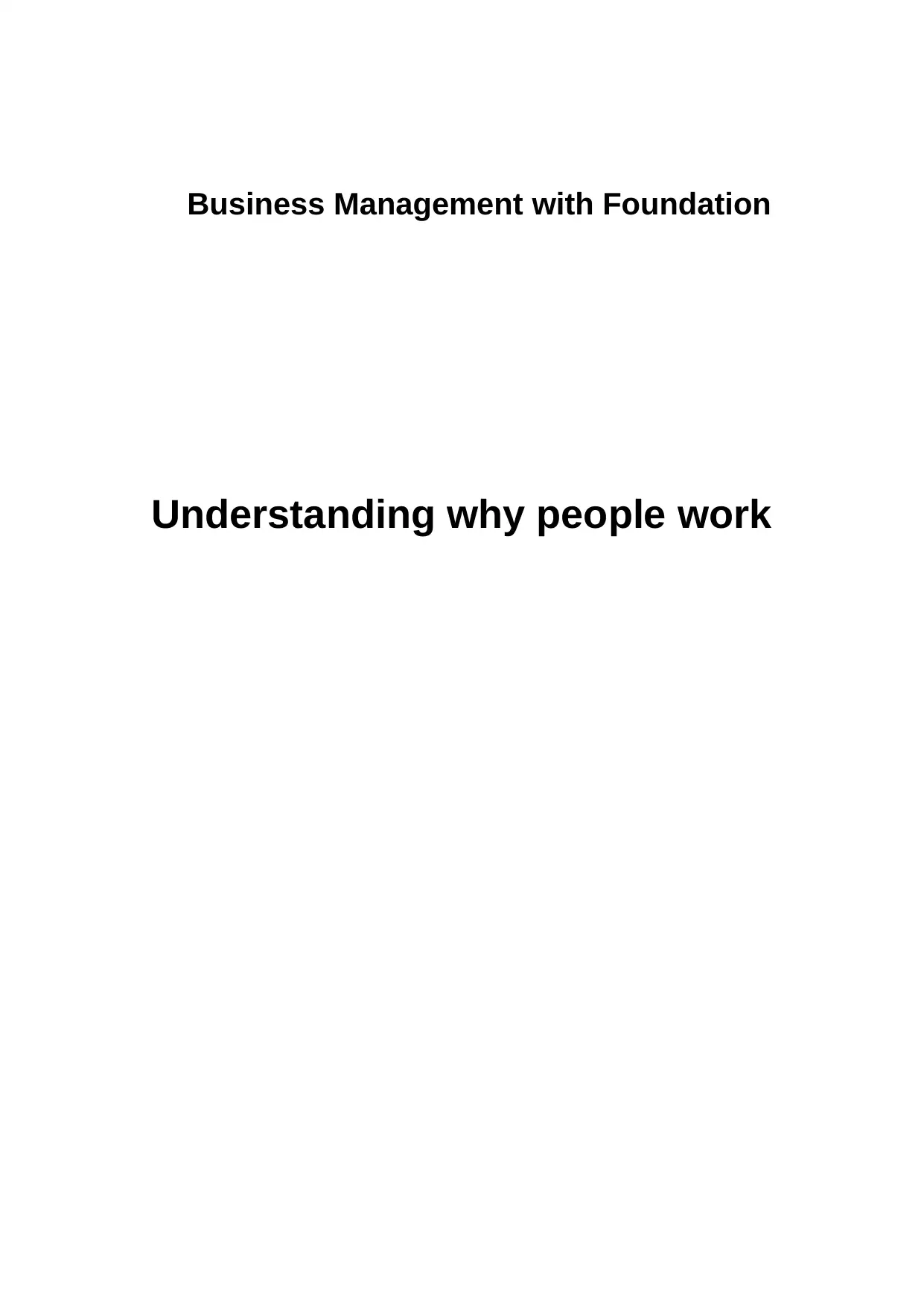
Business Management with Foundation
Understanding why people work
Understanding why people work
Paraphrase This Document
Need a fresh take? Get an instant paraphrase of this document with our AI Paraphraser
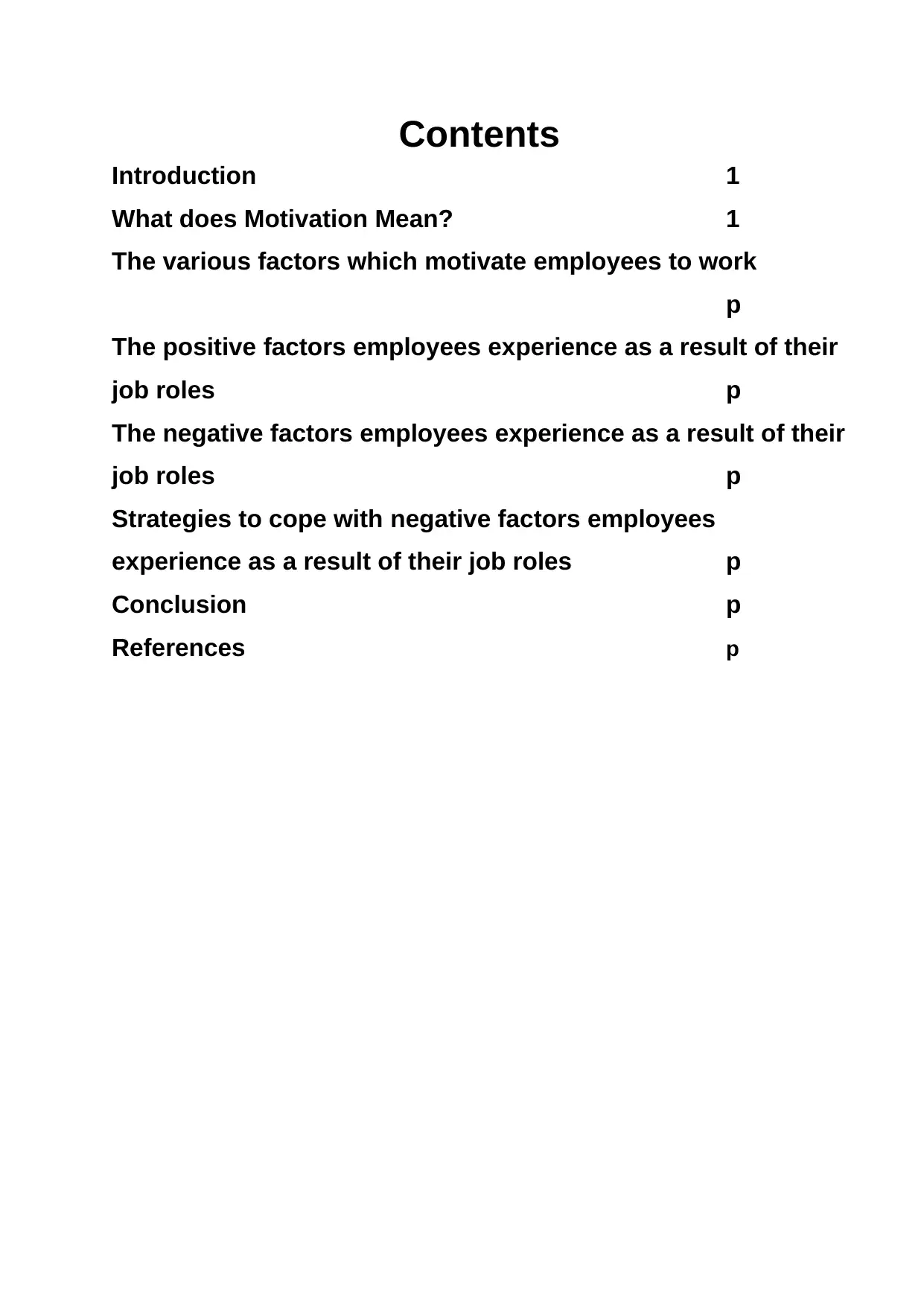
Contents
Introduction 1
What does Motivation Mean? 1
The various factors which motivate employees to work
p
The positive factors employees experience as a result of their
job roles p
The negative factors employees experience as a result of their
job roles p
Strategies to cope with negative factors employees
experience as a result of their job roles p
Conclusion p
References p
Introduction 1
What does Motivation Mean? 1
The various factors which motivate employees to work
p
The positive factors employees experience as a result of their
job roles p
The negative factors employees experience as a result of their
job roles p
Strategies to cope with negative factors employees
experience as a result of their job roles p
Conclusion p
References p
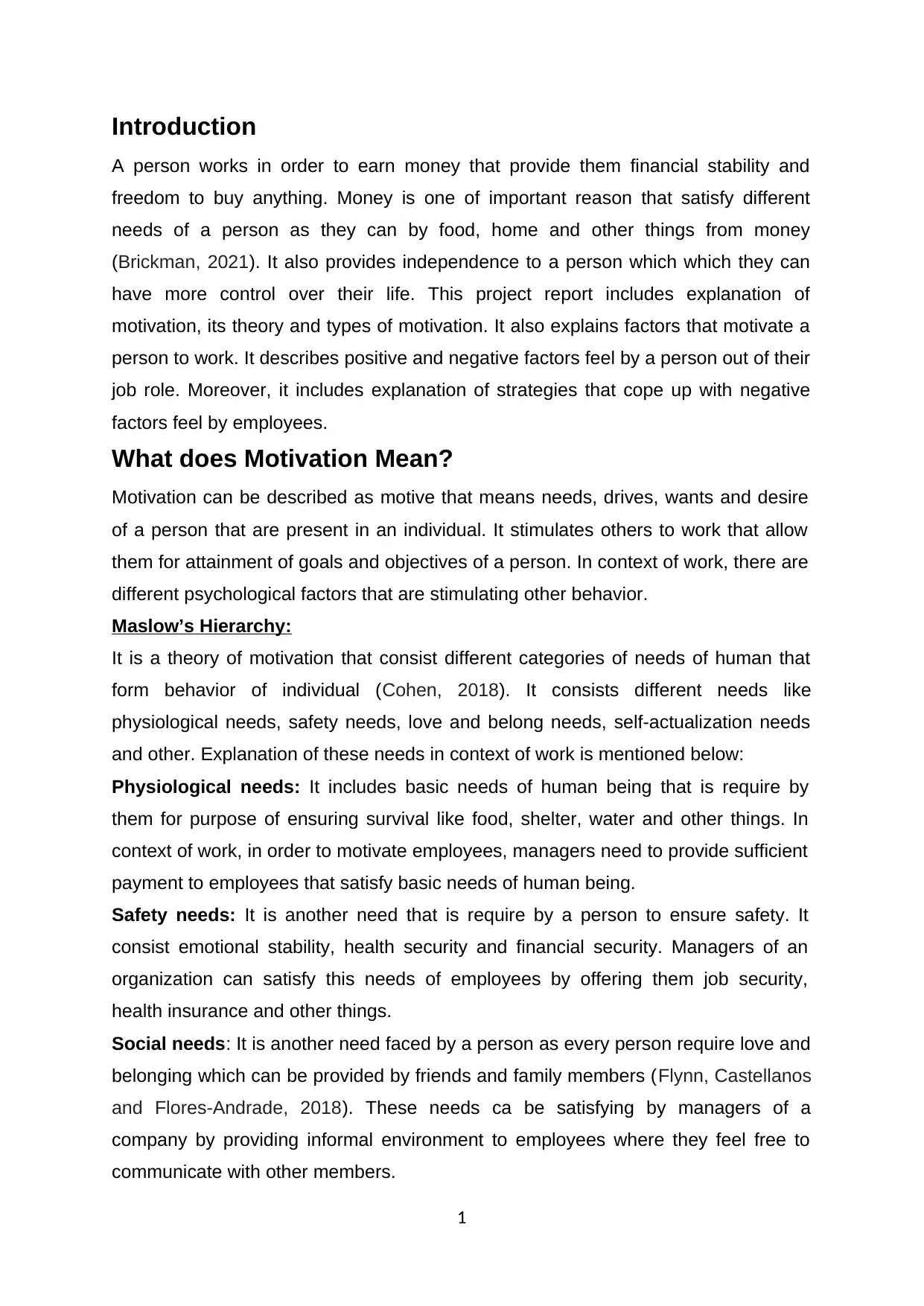
Introduction
A person works in order to earn money that provide them financial stability and
freedom to buy anything. Money is one of important reason that satisfy different
needs of a person as they can by food, home and other things from money
(Brickman, 2021). It also provides independence to a person which which they can
have more control over their life. This project report includes explanation of
motivation, its theory and types of motivation. It also explains factors that motivate a
person to work. It describes positive and negative factors feel by a person out of their
job role. Moreover, it includes explanation of strategies that cope up with negative
factors feel by employees.
What does Motivation Mean?
Motivation can be described as motive that means needs, drives, wants and desire
of a person that are present in an individual. It stimulates others to work that allow
them for attainment of goals and objectives of a person. In context of work, there are
different psychological factors that are stimulating other behavior.
Maslow’s Hierarchy:
It is a theory of motivation that consist different categories of needs of human that
form behavior of individual (Cohen, 2018). It consists different needs like
physiological needs, safety needs, love and belong needs, self-actualization needs
and other. Explanation of these needs in context of work is mentioned below:
Physiological needs: It includes basic needs of human being that is require by
them for purpose of ensuring survival like food, shelter, water and other things. In
context of work, in order to motivate employees, managers need to provide sufficient
payment to employees that satisfy basic needs of human being.
Safety needs: It is another need that is require by a person to ensure safety. It
consist emotional stability, health security and financial security. Managers of an
organization can satisfy this needs of employees by offering them job security,
health insurance and other things.
Social needs: It is another need faced by a person as every person require love and
belonging which can be provided by friends and family members (Flynn, Castellanos
and Flores-Andrade, 2018). These needs ca be satisfying by managers of a
company by providing informal environment to employees where they feel free to
communicate with other members.
1
A person works in order to earn money that provide them financial stability and
freedom to buy anything. Money is one of important reason that satisfy different
needs of a person as they can by food, home and other things from money
(Brickman, 2021). It also provides independence to a person which which they can
have more control over their life. This project report includes explanation of
motivation, its theory and types of motivation. It also explains factors that motivate a
person to work. It describes positive and negative factors feel by a person out of their
job role. Moreover, it includes explanation of strategies that cope up with negative
factors feel by employees.
What does Motivation Mean?
Motivation can be described as motive that means needs, drives, wants and desire
of a person that are present in an individual. It stimulates others to work that allow
them for attainment of goals and objectives of a person. In context of work, there are
different psychological factors that are stimulating other behavior.
Maslow’s Hierarchy:
It is a theory of motivation that consist different categories of needs of human that
form behavior of individual (Cohen, 2018). It consists different needs like
physiological needs, safety needs, love and belong needs, self-actualization needs
and other. Explanation of these needs in context of work is mentioned below:
Physiological needs: It includes basic needs of human being that is require by
them for purpose of ensuring survival like food, shelter, water and other things. In
context of work, in order to motivate employees, managers need to provide sufficient
payment to employees that satisfy basic needs of human being.
Safety needs: It is another need that is require by a person to ensure safety. It
consist emotional stability, health security and financial security. Managers of an
organization can satisfy this needs of employees by offering them job security,
health insurance and other things.
Social needs: It is another need faced by a person as every person require love and
belonging which can be provided by friends and family members (Flynn, Castellanos
and Flores-Andrade, 2018). These needs ca be satisfying by managers of a
company by providing informal environment to employees where they feel free to
communicate with other members.
1
⊘ This is a preview!⊘
Do you want full access?
Subscribe today to unlock all pages.

Trusted by 1+ million students worldwide
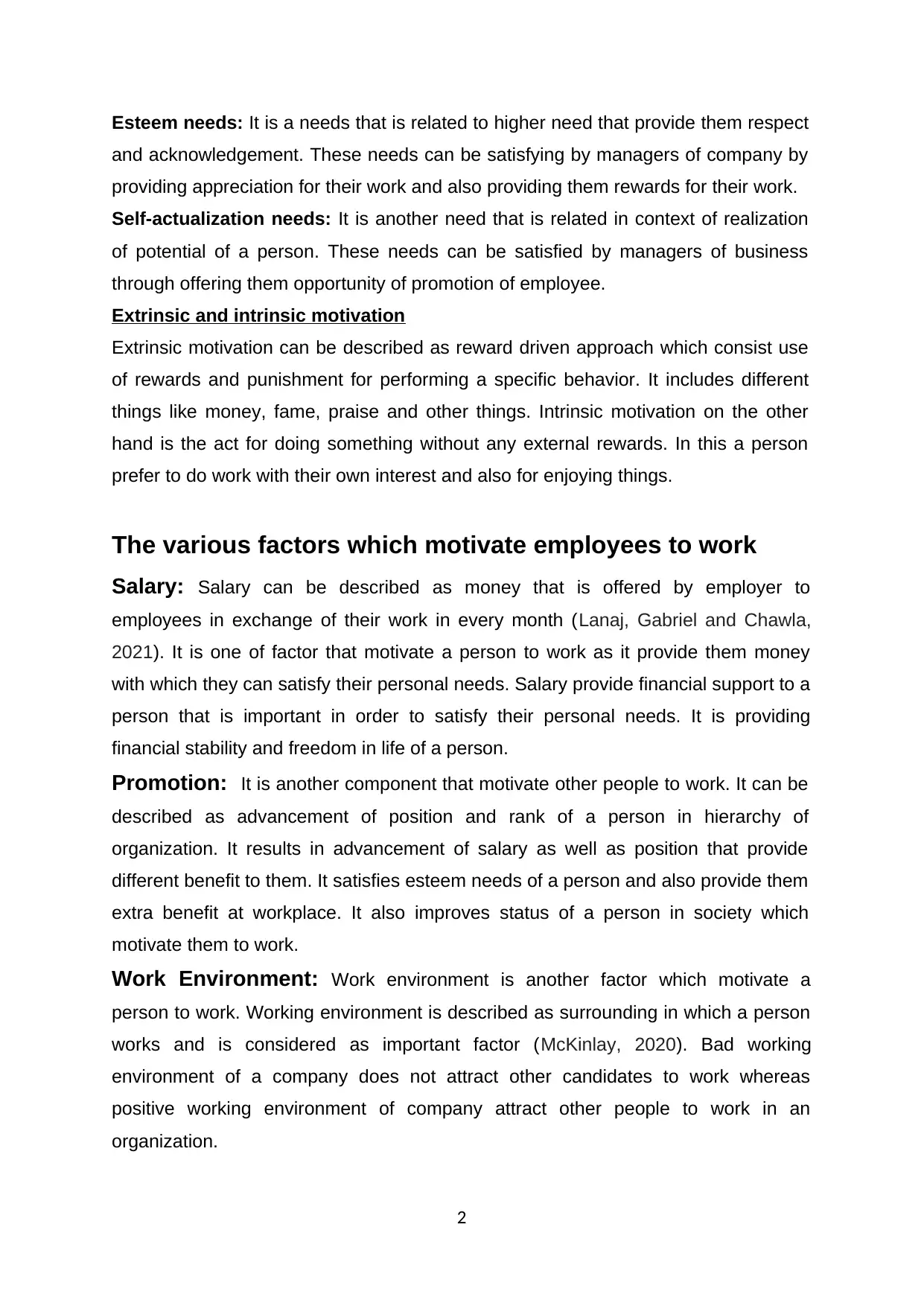
Esteem needs: It is a needs that is related to higher need that provide them respect
and acknowledgement. These needs can be satisfying by managers of company by
providing appreciation for their work and also providing them rewards for their work.
Self-actualization needs: It is another need that is related in context of realization
of potential of a person. These needs can be satisfied by managers of business
through offering them opportunity of promotion of employee.
Extrinsic and intrinsic motivation
Extrinsic motivation can be described as reward driven approach which consist use
of rewards and punishment for performing a specific behavior. It includes different
things like money, fame, praise and other things. Intrinsic motivation on the other
hand is the act for doing something without any external rewards. In this a person
prefer to do work with their own interest and also for enjoying things.
The various factors which motivate employees to work
Salary: Salary can be described as money that is offered by employer to
employees in exchange of their work in every month (Lanaj, Gabriel and Chawla,
2021). It is one of factor that motivate a person to work as it provide them money
with which they can satisfy their personal needs. Salary provide financial support to a
person that is important in order to satisfy their personal needs. It is providing
financial stability and freedom in life of a person.
Promotion: It is another component that motivate other people to work. It can be
described as advancement of position and rank of a person in hierarchy of
organization. It results in advancement of salary as well as position that provide
different benefit to them. It satisfies esteem needs of a person and also provide them
extra benefit at workplace. It also improves status of a person in society which
motivate them to work.
Work Environment: Work environment is another factor which motivate a
person to work. Working environment is described as surrounding in which a person
works and is considered as important factor (McKinlay, 2020). Bad working
environment of a company does not attract other candidates to work whereas
positive working environment of company attract other people to work in an
organization.
2
and acknowledgement. These needs can be satisfying by managers of company by
providing appreciation for their work and also providing them rewards for their work.
Self-actualization needs: It is another need that is related in context of realization
of potential of a person. These needs can be satisfied by managers of business
through offering them opportunity of promotion of employee.
Extrinsic and intrinsic motivation
Extrinsic motivation can be described as reward driven approach which consist use
of rewards and punishment for performing a specific behavior. It includes different
things like money, fame, praise and other things. Intrinsic motivation on the other
hand is the act for doing something without any external rewards. In this a person
prefer to do work with their own interest and also for enjoying things.
The various factors which motivate employees to work
Salary: Salary can be described as money that is offered by employer to
employees in exchange of their work in every month (Lanaj, Gabriel and Chawla,
2021). It is one of factor that motivate a person to work as it provide them money
with which they can satisfy their personal needs. Salary provide financial support to a
person that is important in order to satisfy their personal needs. It is providing
financial stability and freedom in life of a person.
Promotion: It is another component that motivate other people to work. It can be
described as advancement of position and rank of a person in hierarchy of
organization. It results in advancement of salary as well as position that provide
different benefit to them. It satisfies esteem needs of a person and also provide them
extra benefit at workplace. It also improves status of a person in society which
motivate them to work.
Work Environment: Work environment is another factor which motivate a
person to work. Working environment is described as surrounding in which a person
works and is considered as important factor (McKinlay, 2020). Bad working
environment of a company does not attract other candidates to work whereas
positive working environment of company attract other people to work in an
organization.
2
Paraphrase This Document
Need a fresh take? Get an instant paraphrase of this document with our AI Paraphraser
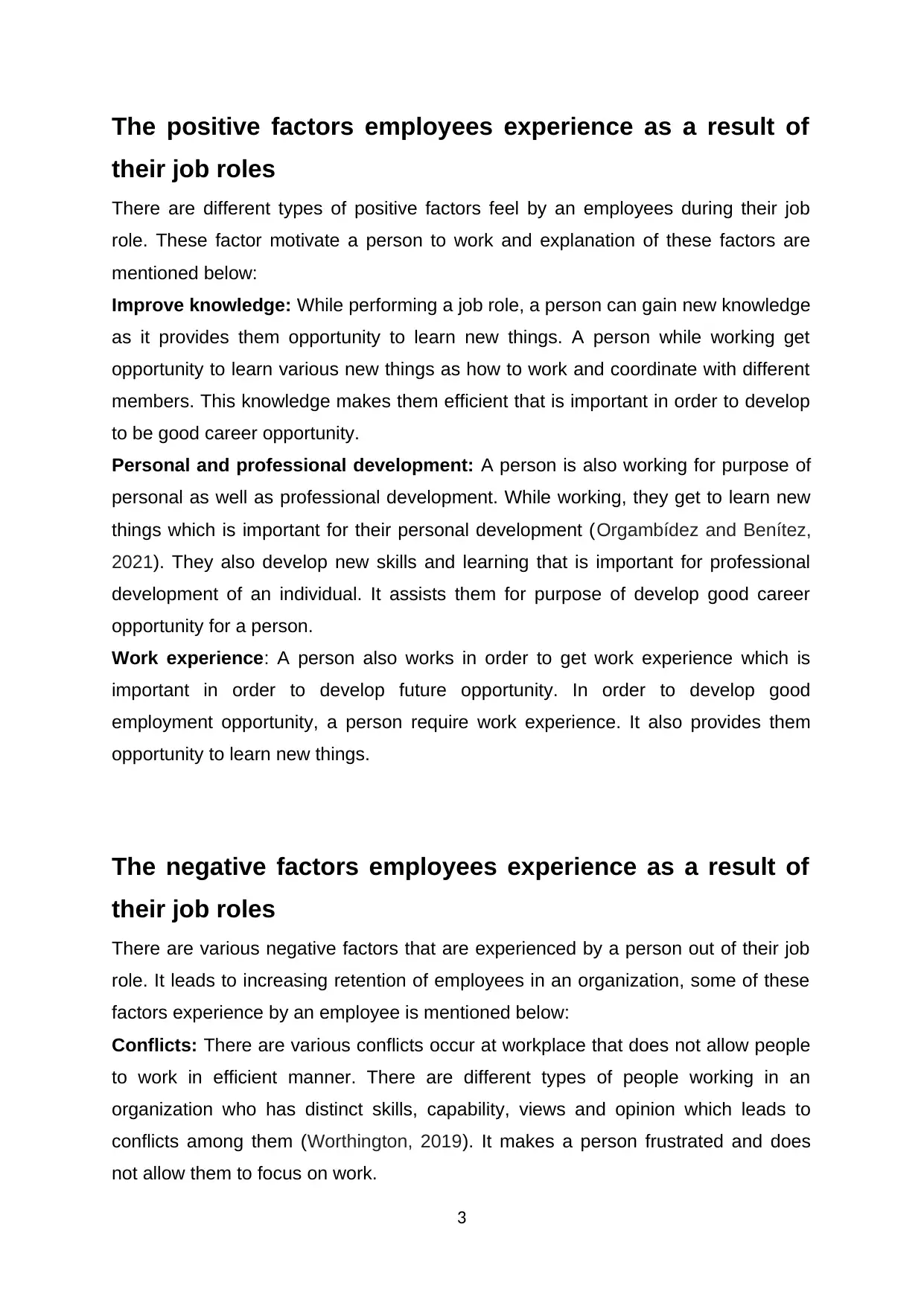
The positive factors employees experience as a result of
their job roles
There are different types of positive factors feel by an employees during their job
role. These factor motivate a person to work and explanation of these factors are
mentioned below:
Improve knowledge: While performing a job role, a person can gain new knowledge
as it provides them opportunity to learn new things. A person while working get
opportunity to learn various new things as how to work and coordinate with different
members. This knowledge makes them efficient that is important in order to develop
to be good career opportunity.
Personal and professional development: A person is also working for purpose of
personal as well as professional development. While working, they get to learn new
things which is important for their personal development (Orgambídez and Benítez,
2021). They also develop new skills and learning that is important for professional
development of an individual. It assists them for purpose of develop good career
opportunity for a person.
Work experience: A person also works in order to get work experience which is
important in order to develop future opportunity. In order to develop good
employment opportunity, a person require work experience. It also provides them
opportunity to learn new things.
The negative factors employees experience as a result of
their job roles
There are various negative factors that are experienced by a person out of their job
role. It leads to increasing retention of employees in an organization, some of these
factors experience by an employee is mentioned below:
Conflicts: There are various conflicts occur at workplace that does not allow people
to work in efficient manner. There are different types of people working in an
organization who has distinct skills, capability, views and opinion which leads to
conflicts among them (Worthington, 2019). It makes a person frustrated and does
not allow them to focus on work.
3
their job roles
There are different types of positive factors feel by an employees during their job
role. These factor motivate a person to work and explanation of these factors are
mentioned below:
Improve knowledge: While performing a job role, a person can gain new knowledge
as it provides them opportunity to learn new things. A person while working get
opportunity to learn various new things as how to work and coordinate with different
members. This knowledge makes them efficient that is important in order to develop
to be good career opportunity.
Personal and professional development: A person is also working for purpose of
personal as well as professional development. While working, they get to learn new
things which is important for their personal development (Orgambídez and Benítez,
2021). They also develop new skills and learning that is important for professional
development of an individual. It assists them for purpose of develop good career
opportunity for a person.
Work experience: A person also works in order to get work experience which is
important in order to develop future opportunity. In order to develop good
employment opportunity, a person require work experience. It also provides them
opportunity to learn new things.
The negative factors employees experience as a result of
their job roles
There are various negative factors that are experienced by a person out of their job
role. It leads to increasing retention of employees in an organization, some of these
factors experience by an employee is mentioned below:
Conflicts: There are various conflicts occur at workplace that does not allow people
to work in efficient manner. There are different types of people working in an
organization who has distinct skills, capability, views and opinion which leads to
conflicts among them (Worthington, 2019). It makes a person frustrated and does
not allow them to focus on work.
3
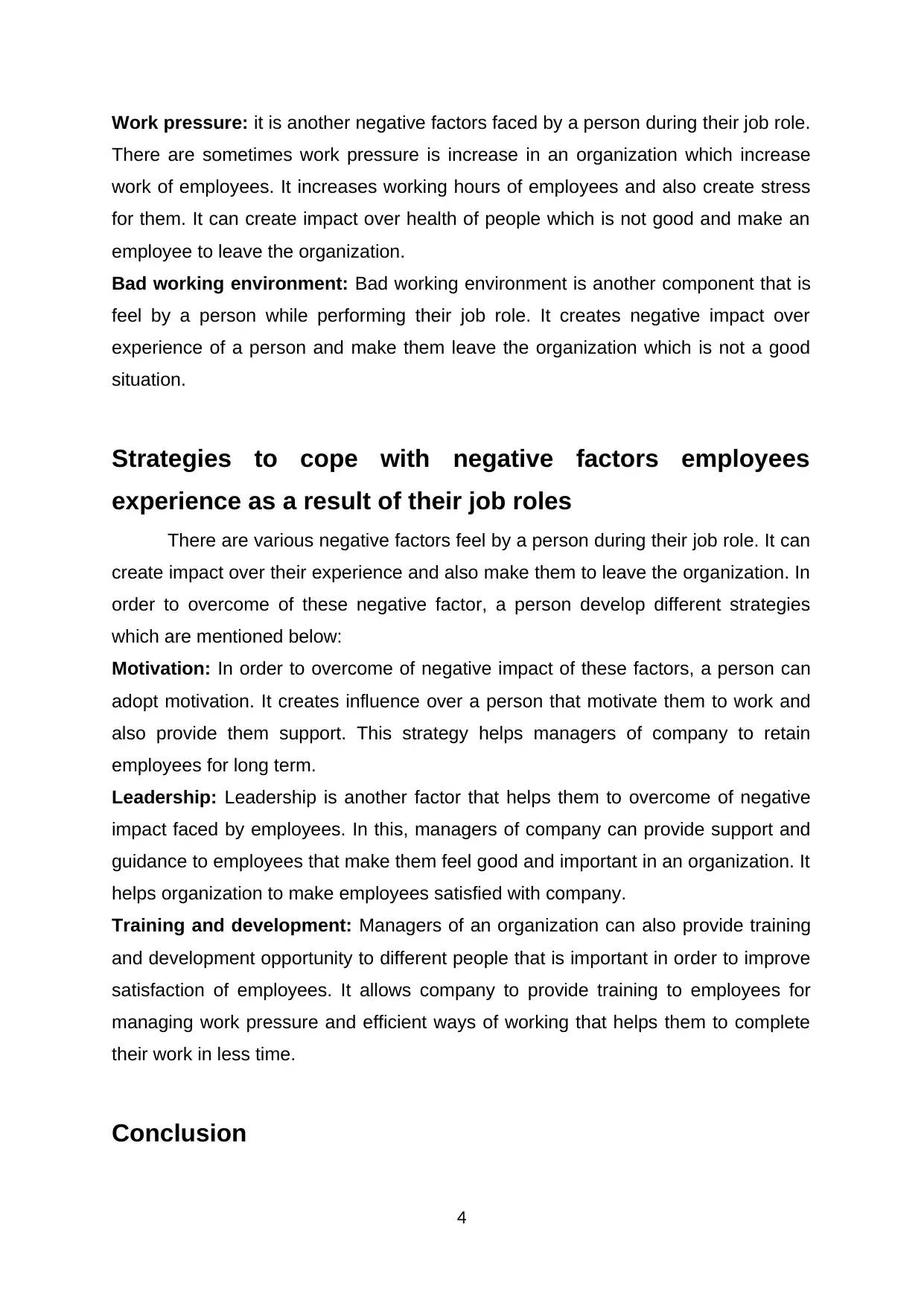
Work pressure: it is another negative factors faced by a person during their job role.
There are sometimes work pressure is increase in an organization which increase
work of employees. It increases working hours of employees and also create stress
for them. It can create impact over health of people which is not good and make an
employee to leave the organization.
Bad working environment: Bad working environment is another component that is
feel by a person while performing their job role. It creates negative impact over
experience of a person and make them leave the organization which is not a good
situation.
Strategies to cope with negative factors employees
experience as a result of their job roles
There are various negative factors feel by a person during their job role. It can
create impact over their experience and also make them to leave the organization. In
order to overcome of these negative factor, a person develop different strategies
which are mentioned below:
Motivation: In order to overcome of negative impact of these factors, a person can
adopt motivation. It creates influence over a person that motivate them to work and
also provide them support. This strategy helps managers of company to retain
employees for long term.
Leadership: Leadership is another factor that helps them to overcome of negative
impact faced by employees. In this, managers of company can provide support and
guidance to employees that make them feel good and important in an organization. It
helps organization to make employees satisfied with company.
Training and development: Managers of an organization can also provide training
and development opportunity to different people that is important in order to improve
satisfaction of employees. It allows company to provide training to employees for
managing work pressure and efficient ways of working that helps them to complete
their work in less time.
Conclusion
4
There are sometimes work pressure is increase in an organization which increase
work of employees. It increases working hours of employees and also create stress
for them. It can create impact over health of people which is not good and make an
employee to leave the organization.
Bad working environment: Bad working environment is another component that is
feel by a person while performing their job role. It creates negative impact over
experience of a person and make them leave the organization which is not a good
situation.
Strategies to cope with negative factors employees
experience as a result of their job roles
There are various negative factors feel by a person during their job role. It can
create impact over their experience and also make them to leave the organization. In
order to overcome of these negative factor, a person develop different strategies
which are mentioned below:
Motivation: In order to overcome of negative impact of these factors, a person can
adopt motivation. It creates influence over a person that motivate them to work and
also provide them support. This strategy helps managers of company to retain
employees for long term.
Leadership: Leadership is another factor that helps them to overcome of negative
impact faced by employees. In this, managers of company can provide support and
guidance to employees that make them feel good and important in an organization. It
helps organization to make employees satisfied with company.
Training and development: Managers of an organization can also provide training
and development opportunity to different people that is important in order to improve
satisfaction of employees. It allows company to provide training to employees for
managing work pressure and efficient ways of working that helps them to complete
their work in less time.
Conclusion
4
⊘ This is a preview!⊘
Do you want full access?
Subscribe today to unlock all pages.

Trusted by 1+ million students worldwide
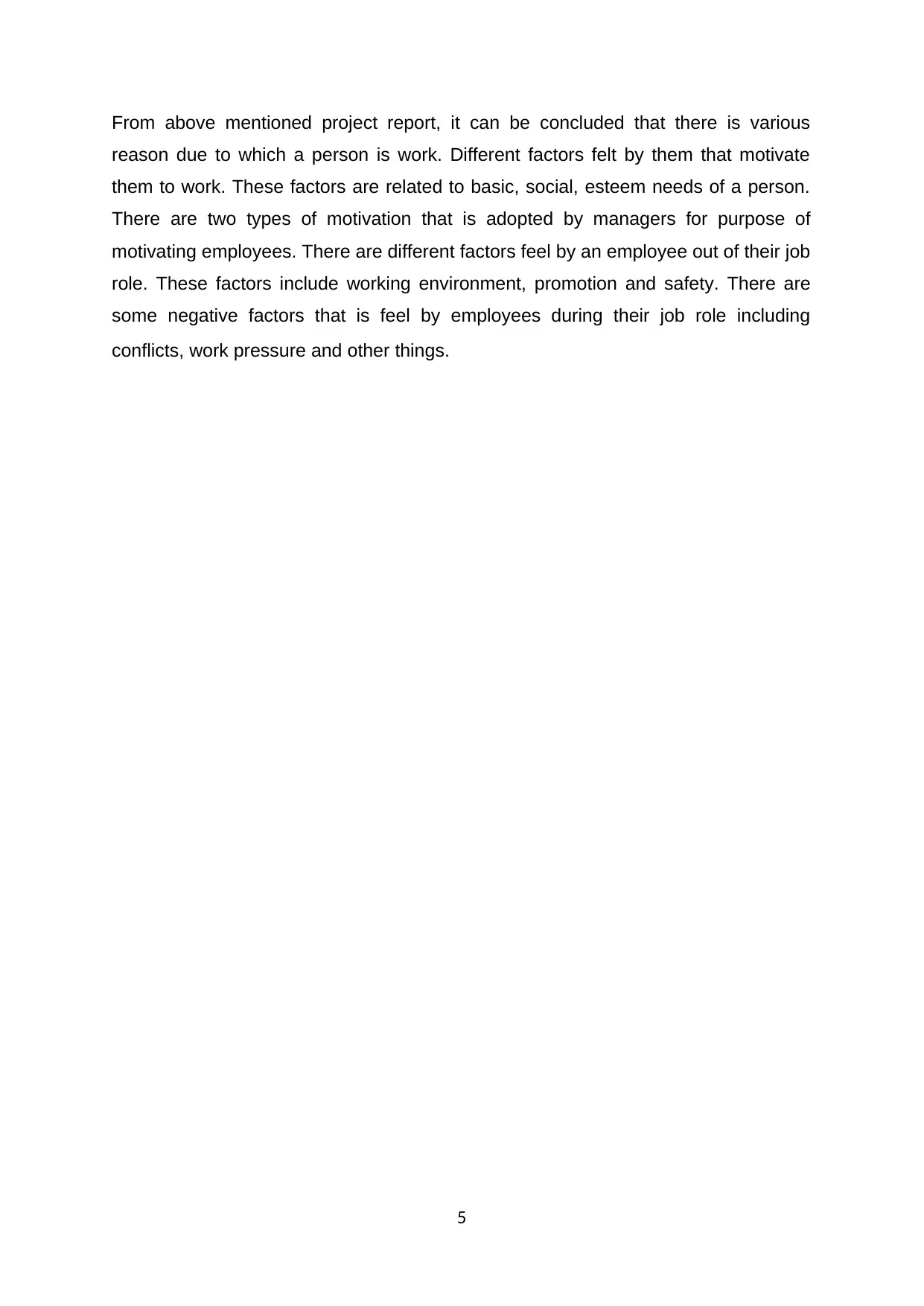
From above mentioned project report, it can be concluded that there is various
reason due to which a person is work. Different factors felt by them that motivate
them to work. These factors are related to basic, social, esteem needs of a person.
There are two types of motivation that is adopted by managers for purpose of
motivating employees. There are different factors feel by an employee out of their job
role. These factors include working environment, promotion and safety. There are
some negative factors that is feel by employees during their job role including
conflicts, work pressure and other things.
5
reason due to which a person is work. Different factors felt by them that motivate
them to work. These factors are related to basic, social, esteem needs of a person.
There are two types of motivation that is adopted by managers for purpose of
motivating employees. There are different factors feel by an employee out of their job
role. These factors include working environment, promotion and safety. There are
some negative factors that is feel by employees during their job role including
conflicts, work pressure and other things.
5
Paraphrase This Document
Need a fresh take? Get an instant paraphrase of this document with our AI Paraphraser
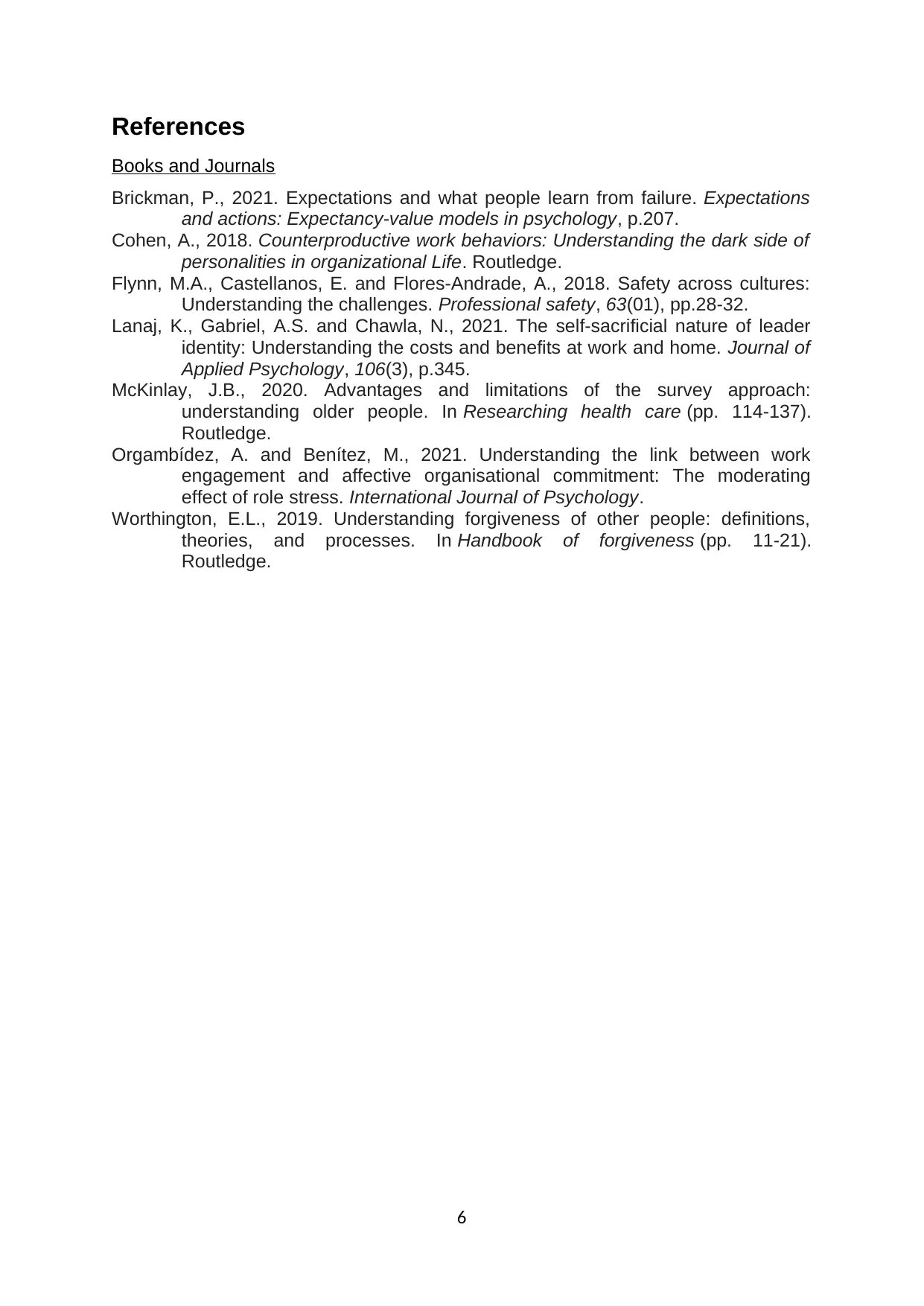
References
Books and Journals
Brickman, P., 2021. Expectations and what people learn from failure. Expectations
and actions: Expectancy-value models in psychology, p.207.
Cohen, A., 2018. Counterproductive work behaviors: Understanding the dark side of
personalities in organizational Life. Routledge.
Flynn, M.A., Castellanos, E. and Flores-Andrade, A., 2018. Safety across cultures:
Understanding the challenges. Professional safety, 63(01), pp.28-32.
Lanaj, K., Gabriel, A.S. and Chawla, N., 2021. The self-sacrificial nature of leader
identity: Understanding the costs and benefits at work and home. Journal of
Applied Psychology, 106(3), p.345.
McKinlay, J.B., 2020. Advantages and limitations of the survey approach:
understanding older people. In Researching health care (pp. 114-137).
Routledge.
Orgambídez, A. and Benítez, M., 2021. Understanding the link between work
engagement and affective organisational commitment: The moderating
effect of role stress. International Journal of Psychology.
Worthington, E.L., 2019. Understanding forgiveness of other people: definitions,
theories, and processes. In Handbook of forgiveness (pp. 11-21).
Routledge.
6
Books and Journals
Brickman, P., 2021. Expectations and what people learn from failure. Expectations
and actions: Expectancy-value models in psychology, p.207.
Cohen, A., 2018. Counterproductive work behaviors: Understanding the dark side of
personalities in organizational Life. Routledge.
Flynn, M.A., Castellanos, E. and Flores-Andrade, A., 2018. Safety across cultures:
Understanding the challenges. Professional safety, 63(01), pp.28-32.
Lanaj, K., Gabriel, A.S. and Chawla, N., 2021. The self-sacrificial nature of leader
identity: Understanding the costs and benefits at work and home. Journal of
Applied Psychology, 106(3), p.345.
McKinlay, J.B., 2020. Advantages and limitations of the survey approach:
understanding older people. In Researching health care (pp. 114-137).
Routledge.
Orgambídez, A. and Benítez, M., 2021. Understanding the link between work
engagement and affective organisational commitment: The moderating
effect of role stress. International Journal of Psychology.
Worthington, E.L., 2019. Understanding forgiveness of other people: definitions,
theories, and processes. In Handbook of forgiveness (pp. 11-21).
Routledge.
6
1 out of 8
Related Documents
Your All-in-One AI-Powered Toolkit for Academic Success.
+13062052269
info@desklib.com
Available 24*7 on WhatsApp / Email
![[object Object]](/_next/static/media/star-bottom.7253800d.svg)
Unlock your academic potential
Copyright © 2020–2025 A2Z Services. All Rights Reserved. Developed and managed by ZUCOL.


